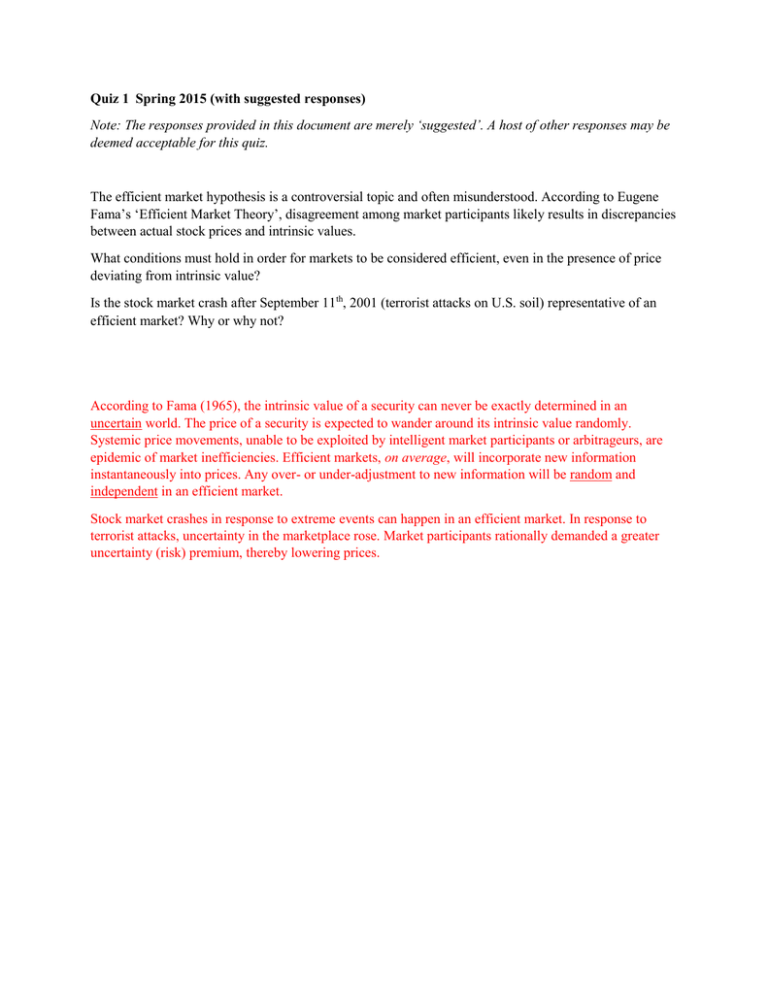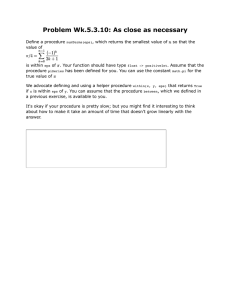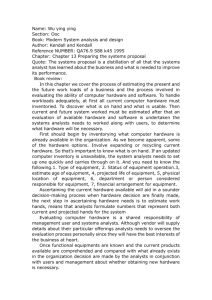Quiz 1 Spring 2015 (with suggested responses) Note: The
advertisement

Quiz 1 Spring 2015 (with suggested responses) Note: The responses provided in this document are merely ‘suggested’. A host of other responses may be deemed acceptable for this quiz. The efficient market hypothesis is a controversial topic and often misunderstood. According to Eugene Fama’s ‘Efficient Market Theory’, disagreement among market participants likely results in discrepancies between actual stock prices and intrinsic values. What conditions must hold in order for markets to be considered efficient, even in the presence of price deviating from intrinsic value? Is the stock market crash after September 11th, 2001 (terrorist attacks on U.S. soil) representative of an efficient market? Why or why not? According to Fama (1965), the intrinsic value of a security can never be exactly determined in an uncertain world. The price of a security is expected to wander around its intrinsic value randomly. Systemic price movements, unable to be exploited by intelligent market participants or arbitrageurs, are epidemic of market inefficiencies. Efficient markets, on average, will incorporate new information instantaneously into prices. Any over- or under-adjustment to new information will be random and independent in an efficient market. Stock market crashes in response to extreme events can happen in an efficient market. In response to terrorist attacks, uncertainty in the marketplace rose. Market participants rationally demanded a greater uncertainty (risk) premium, thereby lowering prices. Consider that on February 15th Husky Co. projects that it will be $0.07 shy of the consensus analyst EPS forecast. Husky's fiscal year ends on March 31st. Identify two real activities that Husky could still undertake during the fiscal year to impact reported EPS. Discuss how these activities would affect reported EPS (i.e., increase or decrease). Identify two financial reporting (accounting-based) opportunities available to Husky’s managers after the end of the fiscal year to impact reported EPS. Discuss how these changes would affect reported EPS (i.e., increase or decrease). Assuming the firm has exhausted all available opportunities to impact reported EPS, identify another opportunity to meet or beat analysts’ forecasts. Two real earnings management activities: reduce discretionary spending (i.e., R&D, Advertising, Maintenance) delay positive NPV projects offer discount pricing to boost revenue Two accounting-based opportunities: adjust assumptions (i.e., pensions; stock options) adjust estimates (i.e., useful life; allowance accounts) Ex-post method to meet or beat analyst forecasts: If the firm has exhausted all EPS reporting options, managers could still possibly meet or beat forecasts by influencing analysts. By ‘walking down’ analysts, managers may be able to lower the consensus forecast, thus reducing any shortfall between reported EPS and the consensus forecast. Analysts’ recommendations often differ on whether to “buy” or “sell” investments. These differences are sometimes attributed to conflicts of interest. Identify three (3) scenarios where a conflict of interest would arise for analysts? What can investors do to make informed decisions even in the presence of conflicts of interest? In what ways do analysts’ research efforts on securities affect market efficiency? Potential conflicts of interest: Institutional frictions (i.e., brokerage house has an ongoing relationship with firm) Analyst holds firm in personal / client portfolio Analyst is compensated based on recommendation Analyst has personal relationship with firm / management To overcome conflicts of interest (and other inherent biases), investors should conduct their own independent research before making investment decisions. Aggregating research efforts from a wide range of analysts may also help to overcome particular idiosyncratic biases. By conducting their own research and disseminating their findings to a wide spectrum of market participants, analysts act to improve price efficiency. Even in the presence of conflicts of interests and other biases, market efficiency likely improves when informed agents trade. With the upcoming election in 2016, CDS Co. is beginning to make donations to a political party. CDS’ Chief Executive Officer (CEO), in an effort to increase transparency, wants to issue a voluntary disclosure on her company's political spending during the past five (5) years; however, there are both costs and benefits associated with these disclosures. Identify two (2) potential costs and two (2) potential benefits associated with adopting voluntary disclosure practices. Voluntary disclosure benefits: Increased transparency lowers information asymmetry between the firm and external market participants (reduced risk premium) Management builds a reputation for being forthcoming (could also lead to considerable costs) Voluntary disclosure costs: Disclosure is sticky. Setting a precedent for certain disclosures may be costly in the future if management wishes to change their policy In this setting, publicly aligning with a particular political group may alienate certain groups, or prompt negative backlash Competitors gain a glimpse into the cost structure of the firm (may not be relevant in this setting, but could lead to competitive disadvantages in other settings) Scientific Games has their gaming software deployed to every casino in New Jersey. They closed yesterday at $12. This morning, the state of New Jersey proposed a bill to legalize online gambling and a reporter for the Wall Street Journal (WSJ) reported that she is “confident that the Senate will vote yes.” This would present an opportunity for Scientific Games to earn $300 million in additional revenue in the first year, or $7 per share. Today Scientific Games closed at $16. Why didn’t the market fully reflect the $7 bump in value created by the proposal? Does the failure to fully adjust to this morning’s news imply market inefficiency? Why or why not? The failure to fully absorb the entire $7 bump into stock price may be a rational response to uncertainty surrounding the passage of the bill. Investors are demanding a risk premium to compensate them for this uncertainty. This price movement does not necessarily imply a failure of market efficiency. Note that if the bill had already passed, and it was certain that the $7 per share would be realized, failing to fully impound this amount into price would violate the criteria for market efficiency. However, in the presence of uncertainty, a partial adjustment seems warranted in this case.



